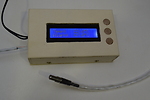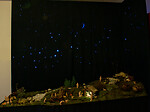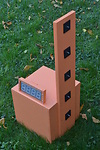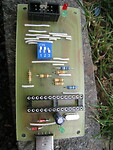 We had a white Christmas in Komenda this year, even though the weather outside was sunny. Some (over 1000) leds, some AVR control with TLC5925 led controllers and we had a nice snow animation that could be changed to show stars arranged in real constellations. The clouds are made from 5mm white plexiglass and illuminated with leds from begind.
I have been etching my own PCBs for almost 10 years now, but now has come a time, when China is so fast and cheap that making your own PCB just does not make sense.
Read more →
We had a white Christmas in Komenda this year, even though the weather outside was sunny. Some (over 1000) leds, some AVR control with TLC5925 led controllers and we had a nice snow animation that could be changed to show stars arranged in real constellations. The clouds are made from 5mm white plexiglass and illuminated with leds from begind.
I have been etching my own PCBs for almost 10 years now, but now has come a time, when China is so fast and cheap that making your own PCB just does not make sense.
Read more →
 Traffic lights are all around us, and they seem simple enough but are they really? Real traffic lights can be a very complicated system because it requires sophisticated control and coordination for smooth and safe traffic.
The traffic light I made is much simpler. My sister works in a kindergarten where kids needed a simple traffic light for when they are riding their bikes on the playground.
The traffic light uses some cheap LEDs from China, a step-up converter and an Atmel attiny841 microcontroller to change the light from red to green at a programmed interval.
Read more →
Traffic lights are all around us, and they seem simple enough but are they really? Real traffic lights can be a very complicated system because it requires sophisticated control and coordination for smooth and safe traffic.
The traffic light I made is much simpler. My sister works in a kindergarten where kids needed a simple traffic light for when they are riding their bikes on the playground.
The traffic light uses some cheap LEDs from China, a step-up converter and an Atmel attiny841 microcontroller to change the light from red to green at a programmed interval.
Read more →
 Anyone who has ever boiled milk on the stove knows, that it has a nasty habit of overflowing. That is why I created the temperature alarm for boiling milk to be used my mother. It continuously measures the temperature of the milk and sounds an alarm when the temperature is over the preset alarm value.
Temperature alarm uses an Atmel attiny841 microcontroller, DS18B20 high temperature waterproof temperature sensor from adafruit, 2x16 HD44780 LCD and a buzzer to do its job.
Read more →
Anyone who has ever boiled milk on the stove knows, that it has a nasty habit of overflowing. That is why I created the temperature alarm for boiling milk to be used my mother. It continuously measures the temperature of the milk and sounds an alarm when the temperature is over the preset alarm value.
Temperature alarm uses an Atmel attiny841 microcontroller, DS18B20 high temperature waterproof temperature sensor from adafruit, 2x16 HD44780 LCD and a buzzer to do its job.
Read more →
 The nativity scene is a several years project, that I upgrade every year. This year I decided they are complex enough to describe on my website.
First a few pictures of the scene, followed by the description of electronics that run the thing. Control The system is controlled by Raspberry Pi. It provides a web interface for the system. The RPi communicates with all parts of the system via an I2C bus.
Read more →
The nativity scene is a several years project, that I upgrade every year. This year I decided they are complex enough to describe on my website.
First a few pictures of the scene, followed by the description of electronics that run the thing. Control The system is controlled by Raspberry Pi. It provides a web interface for the system. The RPi communicates with all parts of the system via an I2C bus.
Read more →
 Game cubes consist of 4 wooden blocks. Primery box with LED display, slave box connected by RF link and two secondary boxes connected only with IR signals. Pairs of boxes are connected with 5 IR lines, with which we can detect passage. The two pairs are connected with CC1101 wireless module. Each box has a 2S LiPo battery and a soft power button. On primary box is an LED display.
Read more →
Game cubes consist of 4 wooden blocks. Primery box with LED display, slave box connected by RF link and two secondary boxes connected only with IR signals. Pairs of boxes are connected with 5 IR lines, with which we can detect passage. The two pairs are connected with CC1101 wireless module. Each box has a 2S LiPo battery and a soft power button. On primary box is an LED display.
Read more →
 Lego robot is a cheaper alternative to a (too) expensive LEGO NXT. Two HUB-ee wheels are used for driving. It is controlled by two AVR microcontrollers - ATTiny 2313A takes care of PID control, soft-power button and USB communication over ft232, ATMega 32A is user programmable (over USB and ATTiny) and it controls everything else. On main PCB are also a 1117 5v regulator, standard hd44780 2x16 character LCD, a few buttons, a speaker and connectors for external sensors and LEDs.
Read more →
Lego robot is a cheaper alternative to a (too) expensive LEGO NXT. Two HUB-ee wheels are used for driving. It is controlled by two AVR microcontrollers - ATTiny 2313A takes care of PID control, soft-power button and USB communication over ft232, ATMega 32A is user programmable (over USB and ATTiny) and it controls everything else. On main PCB are also a 1117 5v regulator, standard hd44780 2x16 character LCD, a few buttons, a speaker and connectors for external sensors and LEDs.
Read more →
 Description The circuit uses 555 and 4017 integrated circuits to turn each of the 10 LEDs one after another. The LEDs are placed in a circle to create the effect of spining - just like a light in a lighthouse. The speed can be controlled with a variable resistor.
I am selling on tindie:\
Operation Required skills Knowledge of basic electronic components Soldering of THT components Theory LED diodes 555 integrated circuit 4017 IC The kit for building a DIY lighthouse contains following items Main printed circuit board 47k, 10k, 330R resistors 1M variable resistor (trimmer) 100uF, 0,47uF, 100nF capacitors 555, 4017 ICs with sockets 90 degrees header LED pcb 10 white LEDs Battery connector Wire Switch Assembly First you have to solder sockets for both ICs on the main pcb (rectangular, green).
Read more →
Description The circuit uses 555 and 4017 integrated circuits to turn each of the 10 LEDs one after another. The LEDs are placed in a circle to create the effect of spining - just like a light in a lighthouse. The speed can be controlled with a variable resistor.
I am selling on tindie:\
Operation Required skills Knowledge of basic electronic components Soldering of THT components Theory LED diodes 555 integrated circuit 4017 IC The kit for building a DIY lighthouse contains following items Main printed circuit board 47k, 10k, 330R resistors 1M variable resistor (trimmer) 100uF, 0,47uF, 100nF capacitors 555, 4017 ICs with sockets 90 degrees header LED pcb 10 white LEDs Battery connector Wire Switch Assembly First you have to solder sockets for both ICs on the main pcb (rectangular, green).
Read more →
 I finally managed to finish my first adjustable bench power supply, that I designed a long time ago when I was just beginning in the field of electronics. That is why it is not the best power supply possible, but it will satisfy most of my needs. Advantages: Preselected commonly used voltages and an option to set voltage accurately with a 10-turn potentiometer Current limit Linear regulator Clear and accurate current and voltage meter display Small dimensions Nice look for a DIY Fast and simple on/off switch for output voltage with a simple button Disadvantages: Because it has only one transformer winding with quiet high voltage (30V) and is linearly regulated a lot of power and heat is produced so current is limited to about 1.
Read more →
I finally managed to finish my first adjustable bench power supply, that I designed a long time ago when I was just beginning in the field of electronics. That is why it is not the best power supply possible, but it will satisfy most of my needs. Advantages: Preselected commonly used voltages and an option to set voltage accurately with a 10-turn potentiometer Current limit Linear regulator Clear and accurate current and voltage meter display Small dimensions Nice look for a DIY Fast and simple on/off switch for output voltage with a simple button Disadvantages: Because it has only one transformer winding with quiet high voltage (30V) and is linearly regulated a lot of power and heat is produced so current is limited to about 1.
Read more →
 Ersa RDS80 is a great soldering station for hobby use, that offers a lot for an affordable price. But it has one weakness - an unappropriate cable for the soldering iron. It is neither heat resistant nor flexible. After using the soldering station for two years, I decided it was time to change the cable.
Although the connector on the soldering station has 4 contacts, only 3 of them are used and the cable has three wires.
Read more →
Ersa RDS80 is a great soldering station for hobby use, that offers a lot for an affordable price. But it has one weakness - an unappropriate cable for the soldering iron. It is neither heat resistant nor flexible. After using the soldering station for two years, I decided it was time to change the cable.
Although the connector on the soldering station has 4 contacts, only 3 of them are used and the cable has three wires.
Read more →
 I’ve already had a programmer for Atmel’s AVR microcontrollers, but I couldn’t use it in my lab, because my laptop doesn’t have a LPT port. So I decided to make a new programmer with USB connection. I’ve found an open source programmer AVR doper, and for the basis I took a modified version from the http://www.kreuzholzen.de web page. I designed a new singled sided PCB board, that I was able to make at home.
Read more →
I’ve already had a programmer for Atmel’s AVR microcontrollers, but I couldn’t use it in my lab, because my laptop doesn’t have a LPT port. So I decided to make a new programmer with USB connection. I’ve found an open source programmer AVR doper, and for the basis I took a modified version from the http://www.kreuzholzen.de web page. I designed a new singled sided PCB board, that I was able to make at home.
Read more →
 We had a white Christmas in Komenda this year, even though the weather outside was sunny. Some (over 1000) leds, some AVR control with TLC5925 led controllers and we had a nice snow animation that could be changed to show stars arranged in real constellations. The clouds are made from 5mm white plexiglass and illuminated with leds from begind.
I have been etching my own PCBs for almost 10 years now, but now has come a time, when China is so fast and cheap that making your own PCB just does not make sense.
Read more →
We had a white Christmas in Komenda this year, even though the weather outside was sunny. Some (over 1000) leds, some AVR control with TLC5925 led controllers and we had a nice snow animation that could be changed to show stars arranged in real constellations. The clouds are made from 5mm white plexiglass and illuminated with leds from begind.
I have been etching my own PCBs for almost 10 years now, but now has come a time, when China is so fast and cheap that making your own PCB just does not make sense.
Read more →
 Traffic lights are all around us, and they seem simple enough but are they really? Real traffic lights can be a very complicated system because it requires sophisticated control and coordination for smooth and safe traffic.
The traffic light I made is much simpler. My sister works in a kindergarten where kids needed a simple traffic light for when they are riding their bikes on the playground.
The traffic light uses some cheap LEDs from China, a step-up converter and an Atmel attiny841 microcontroller to change the light from red to green at a programmed interval.
Traffic lights are all around us, and they seem simple enough but are they really? Real traffic lights can be a very complicated system because it requires sophisticated control and coordination for smooth and safe traffic.
The traffic light I made is much simpler. My sister works in a kindergarten where kids needed a simple traffic light for when they are riding their bikes on the playground.
The traffic light uses some cheap LEDs from China, a step-up converter and an Atmel attiny841 microcontroller to change the light from red to green at a programmed interval.
 Anyone who has ever boiled milk on the stove knows, that it has a nasty habit of overflowing. That is why I created the temperature alarm for boiling milk to be used my mother. It continuously measures the temperature of the milk and sounds an alarm when the temperature is over the preset alarm value.
Temperature alarm uses an Atmel attiny841 microcontroller, DS18B20 high temperature waterproof temperature sensor from adafruit, 2x16 HD44780 LCD and a buzzer to do its job.
Anyone who has ever boiled milk on the stove knows, that it has a nasty habit of overflowing. That is why I created the temperature alarm for boiling milk to be used my mother. It continuously measures the temperature of the milk and sounds an alarm when the temperature is over the preset alarm value.
Temperature alarm uses an Atmel attiny841 microcontroller, DS18B20 high temperature waterproof temperature sensor from adafruit, 2x16 HD44780 LCD and a buzzer to do its job.
 The nativity scene is a several years project, that I upgrade every year. This year I decided they are complex enough to describe on my website.
First a few pictures of the scene, followed by the description of electronics that run the thing. Control The system is controlled by Raspberry Pi. It provides a web interface for the system. The RPi communicates with all parts of the system via an I2C bus.
The nativity scene is a several years project, that I upgrade every year. This year I decided they are complex enough to describe on my website.
First a few pictures of the scene, followed by the description of electronics that run the thing. Control The system is controlled by Raspberry Pi. It provides a web interface for the system. The RPi communicates with all parts of the system via an I2C bus.
 Game cubes consist of 4 wooden blocks. Primery box with LED display, slave box connected by RF link and two secondary boxes connected only with IR signals. Pairs of boxes are connected with 5 IR lines, with which we can detect passage. The two pairs are connected with CC1101 wireless module. Each box has a 2S LiPo battery and a soft power button. On primary box is an LED display.
Game cubes consist of 4 wooden blocks. Primery box with LED display, slave box connected by RF link and two secondary boxes connected only with IR signals. Pairs of boxes are connected with 5 IR lines, with which we can detect passage. The two pairs are connected with CC1101 wireless module. Each box has a 2S LiPo battery and a soft power button. On primary box is an LED display.
 Lego robot is a cheaper alternative to a (too) expensive LEGO NXT. Two HUB-ee wheels are used for driving. It is controlled by two AVR microcontrollers - ATTiny 2313A takes care of PID control, soft-power button and USB communication over ft232, ATMega 32A is user programmable (over USB and ATTiny) and it controls everything else. On main PCB are also a 1117 5v regulator, standard hd44780 2x16 character LCD, a few buttons, a speaker and connectors for external sensors and LEDs.
Lego robot is a cheaper alternative to a (too) expensive LEGO NXT. Two HUB-ee wheels are used for driving. It is controlled by two AVR microcontrollers - ATTiny 2313A takes care of PID control, soft-power button and USB communication over ft232, ATMega 32A is user programmable (over USB and ATTiny) and it controls everything else. On main PCB are also a 1117 5v regulator, standard hd44780 2x16 character LCD, a few buttons, a speaker and connectors for external sensors and LEDs.
 Description The circuit uses 555 and 4017 integrated circuits to turn each of the 10 LEDs one after another. The LEDs are placed in a circle to create the effect of spining - just like a light in a lighthouse. The speed can be controlled with a variable resistor.
I am selling on tindie:\
Operation Required skills Knowledge of basic electronic components Soldering of THT components Theory LED diodes 555 integrated circuit 4017 IC The kit for building a DIY lighthouse contains following items Main printed circuit board 47k, 10k, 330R resistors 1M variable resistor (trimmer) 100uF, 0,47uF, 100nF capacitors 555, 4017 ICs with sockets 90 degrees header LED pcb 10 white LEDs Battery connector Wire Switch Assembly First you have to solder sockets for both ICs on the main pcb (rectangular, green).
Description The circuit uses 555 and 4017 integrated circuits to turn each of the 10 LEDs one after another. The LEDs are placed in a circle to create the effect of spining - just like a light in a lighthouse. The speed can be controlled with a variable resistor.
I am selling on tindie:\
Operation Required skills Knowledge of basic electronic components Soldering of THT components Theory LED diodes 555 integrated circuit 4017 IC The kit for building a DIY lighthouse contains following items Main printed circuit board 47k, 10k, 330R resistors 1M variable resistor (trimmer) 100uF, 0,47uF, 100nF capacitors 555, 4017 ICs with sockets 90 degrees header LED pcb 10 white LEDs Battery connector Wire Switch Assembly First you have to solder sockets for both ICs on the main pcb (rectangular, green).
 I finally managed to finish my first adjustable bench power supply, that I designed a long time ago when I was just beginning in the field of electronics. That is why it is not the best power supply possible, but it will satisfy most of my needs. Advantages: Preselected commonly used voltages and an option to set voltage accurately with a 10-turn potentiometer Current limit Linear regulator Clear and accurate current and voltage meter display Small dimensions Nice look for a DIY Fast and simple on/off switch for output voltage with a simple button Disadvantages: Because it has only one transformer winding with quiet high voltage (30V) and is linearly regulated a lot of power and heat is produced so current is limited to about 1.
I finally managed to finish my first adjustable bench power supply, that I designed a long time ago when I was just beginning in the field of electronics. That is why it is not the best power supply possible, but it will satisfy most of my needs. Advantages: Preselected commonly used voltages and an option to set voltage accurately with a 10-turn potentiometer Current limit Linear regulator Clear and accurate current and voltage meter display Small dimensions Nice look for a DIY Fast and simple on/off switch for output voltage with a simple button Disadvantages: Because it has only one transformer winding with quiet high voltage (30V) and is linearly regulated a lot of power and heat is produced so current is limited to about 1.
 Ersa RDS80 is a great soldering station for hobby use, that offers a lot for an affordable price. But it has one weakness - an unappropriate cable for the soldering iron. It is neither heat resistant nor flexible. After using the soldering station for two years, I decided it was time to change the cable.
Although the connector on the soldering station has 4 contacts, only 3 of them are used and the cable has three wires.
Ersa RDS80 is a great soldering station for hobby use, that offers a lot for an affordable price. But it has one weakness - an unappropriate cable for the soldering iron. It is neither heat resistant nor flexible. After using the soldering station for two years, I decided it was time to change the cable.
Although the connector on the soldering station has 4 contacts, only 3 of them are used and the cable has three wires.
 I’ve already had a programmer for Atmel’s AVR microcontrollers, but I couldn’t use it in my lab, because my laptop doesn’t have a LPT port. So I decided to make a new programmer with USB connection. I’ve found an open source programmer AVR doper, and for the basis I took a modified version from the http://www.kreuzholzen.de web page. I designed a new singled sided PCB board, that I was able to make at home.
I’ve already had a programmer for Atmel’s AVR microcontrollers, but I couldn’t use it in my lab, because my laptop doesn’t have a LPT port. So I decided to make a new programmer with USB connection. I’ve found an open source programmer AVR doper, and for the basis I took a modified version from the http://www.kreuzholzen.de web page. I designed a new singled sided PCB board, that I was able to make at home.